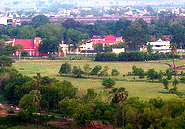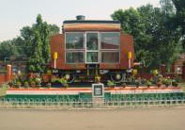Welcome to Jamalpur the world’s most beautiful place! Munger, Bihar
Welcome to Jamalpur ||Munger, BiharArchive for September, 2011
The old palace buildings within the fort along the riverside at Monghyr (Bihar).
Watercolour of palace buildings in Bihar originally from ‘Views by Seeta Ram from Moorsheedabad to Patna Vol. I’ produced for Lord Moira, afterwards the Marquess of Hastings, by Sita Ram between 1814-15. Marquess of Hastings, the Governor-General of Bengal and the Commander-in-Chief (r. 1813-23), was accompanied by artist Sita Ram (flourished c.1810-22) to illustrate his journey from Calcutta to Delhi between 1814-15.Idealised view of the old palace buildings within the fort along the riverside at Monghyr (Bihar). The fort at Monghyr was occupied by Nawab Mir Kasim of Bengal and a principal defence point during the battle at Udhua Nullah when he was defeated by Major Adams in 1763. Inscribed below (cut out from original backing paper): ‘Riverside at Monghir’.
Rights: Copyright © British Library Board
The European Library
भूकंप के बाद बिहार-झारखंड में मोबाइल नेटवर्क जाम
भूकंप के तेज झटकों के बाद बिहार और झारखंड में अचानक मोबाइल नेटवर्क जाम हो गया.
बिहार और झारखंड में भूकंप के तेज झटके आते ही मोबाइल नेटवर्क को भी झटका लग गया.
रविवार शाम 6 बज कर 11 मिनट पर जैसे ही जलजला आया, एक-एक करके सारे मोबाइल नेटवर्क जाम हो गए.
वोडाफोन, आइडिया, रिलायंस और एयरटेल पर बिहार-झारखंड से न तो कोई कॉल बाहर जा पा रहा था और ना ही इन राज्यों से बाहर के लोग वहां फोन कर पा रहे थे.
मोबाइल कनेक्ट होने की बजाए सिर्फ़ दो संदेश दे रहा था- उपभोक्ता संपर्क क्षेत्र से बाहर है या नेटवर्क बिजी.
दरअसल रिक्टर पैमाने पर 6.8 की तीव्रता ने पूरे इलाके को झकझोर कर रख दिया और देखते ही देखते परिवार के रिश्तेदारों और मित्रों ने हालचाल जानने के लिए फोन का इस्तेमाल करना चाहा.
हालांकि मोबाइल कंपनियों की ओर से नेटवर्क जाम होने का कोई कारण नहीं बताया गया है लेकिन आम तौर पर अचानक कॉल की संख्या बढ़ जाने से ऐसा होता है.
YouTube is Bihar’s new anti-bribe tool
Patna: Fight against corruption in Bihar is being taken to a different level. After confiscating properties of senior bureaucrats, now the internet is being used as yet another tool. People are being encouraged to voice their personal experiences regarding corruption, name bribe seekers and post them on YouTube, a leading video sharing website. The idea is to make these names public so that it deters others doing the same.
Santosh Paswan is a relieved man today as his complaint has been heard. Santosh was asked a Rs 5,000 bribe for the allocation of a house under the Indira Awas Yojana. His compliant now echoes on YouTube, the leading video sharing website.
Santosh Paswan said, “The incident which took place with me at Indira Awas, with middle-men asking for money, I have my story recorded in a video now.”
Read more: YouTube is Bihar’s new anti-bribe tool
Android smartphones used to monitor MNREGA projects in Bihar
The Munger District administration in Bihar has recently deployed Bizframe’s Mobile Inspector on Android smartphones to monitor MNREGA schemes
Monitoring of projects under the Mahatma Gandhi National Rural Employment Guarantee Act (MNREGA) in Bihar has gone hi-tech with introduction of mobile based solutions.
The District administration of Munger in Bihar has taken the initiative and has deployed Bizframe’s Mobile Inspector on Android Smartphone to monitor MNREGA schemes in all panchayats of all its 8 blocks.
This brings in an unprecedented level of transparency of project status and progress of MNREGA projects which are very difficult to monitor, given the remotely located villages and poor connectivity.
The solutions help site supervisors quickly complete their project report or inspections while on the job and send them immediately, over mobile networks, saving several hours of clerical work and travel, each day.
The system provides instant reporting features including image/ photographs and GPS location of the report.
Project officers at all blocks have been provided with an Android powered Smartphone, which are commonly available in the market.
The results have been very encouraging with project officers sending in detailed reports of ongoing projects/ workers on site, images of working labourers, image proof of social audit meetings among others.
—iGovernment Bureau
MUNGER – Historical Pointers
The territory included within the district of Munger (famously Monghyr) formed pent of the Madhya-desa as “Midland” of the first Aryan settlers. It has been identified with Mod-Giri a place mentioned in the Mahabharata, which was the capital of a kingdom in Eastern India near Vanga and Tamralipta. In the Digvijaya Parva of Mahabharata, we find the mention of Moda-Giri, Which seems similar to Moda-Giri. Digvijaya Parva suggests that it was a monarchical state during early times. A passage in the Sabha-Parva describes Bhima’s conquest in Eastern India and says that after defeating Karna, king of Anga, he fought battle at Modagiri and killed its chief. It was also known as Maudal after Maudgalya, a disciple of Buddha, who converted a rich merchant of this place into Buddhism. Buchanan says that it was the hermitage of Mudgala Muni and this tradition of Mudgal Risi still persists. Munger is called “Modagiri” in the Monghyr copperplate of Devapala. The derivation of the name Munger (Monghyr) has found the subject of much speculation. Tradition arcribes the foundation of the town to Chandragupta, after whom it was called Guptagars a name which has been found inscribed on a rock at Kastaharni Ghat at the north-western corner of the present fort. It is insisted that Mudgalrisi lived there. Tradition ascribes the composition of various suktar of the 10th Mavdala of the Rigveda to Rishi Mudgal and his clan. However, General Cunnigham had strong suspicicion when he connects this original name with Mons as Mundas, who occupied this part before the advent of the Aryans. Again Mr. C.E.A. oldham, ICS, a farmer collector suggests the possibility of Munigiha, ie , the abode of the Muni, without any specification which later corrupted to Mungir and later became Munger.
At the dawn of history, the present site of the town was apparently comprised within the Kingdom of Anga, with the capital Champa near Bhagalpur. According to Pargiter, Anga comprises the modern districts of Bhagalpur and Munger commissionary. The Anga dominion at one time included Magadha and the Shanti-Parva refers to an Anga king who sacrificed at Mount Vishnupada. In the epic period Modagiri finds mention as a separate state. The success of the Anga did not last long and about the middle of the sixth century B.C. Bimlisara of Magadha is said to have killed Brahmadatta, the last independent ruler of ancient Anga. Hence the Anga became an integral part of the growing empire of Magadh. As epigraphic evidence of the Gupta period suggests that Munger was under the Guptas. To the reign of Buddhagupta (447-495 A.D) belongs a copper plate of A.D. 488-9 originally found at Mandapura in the district.



















